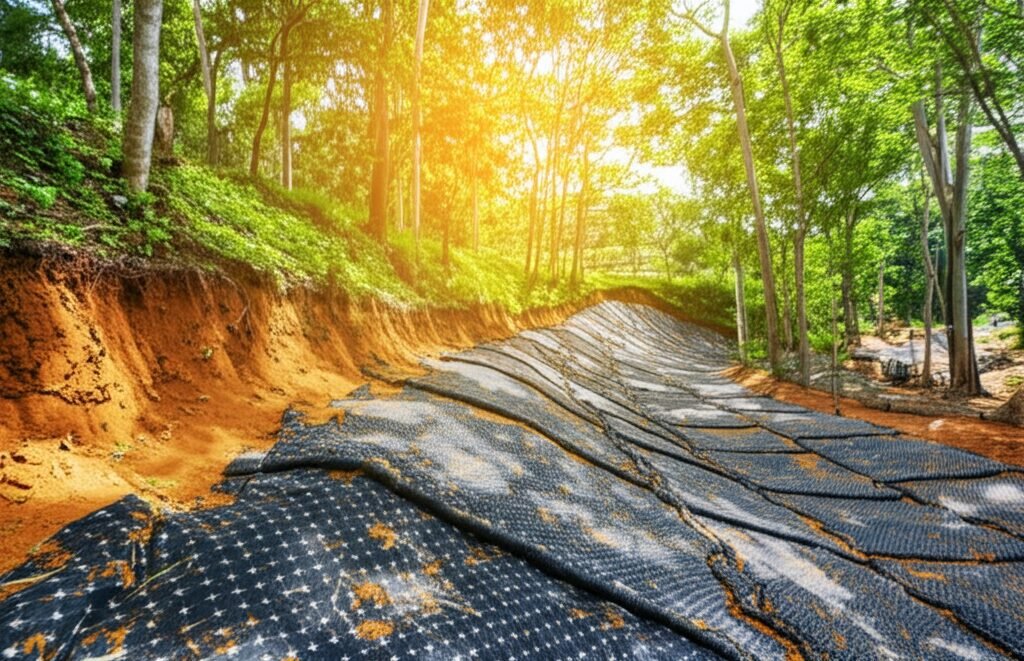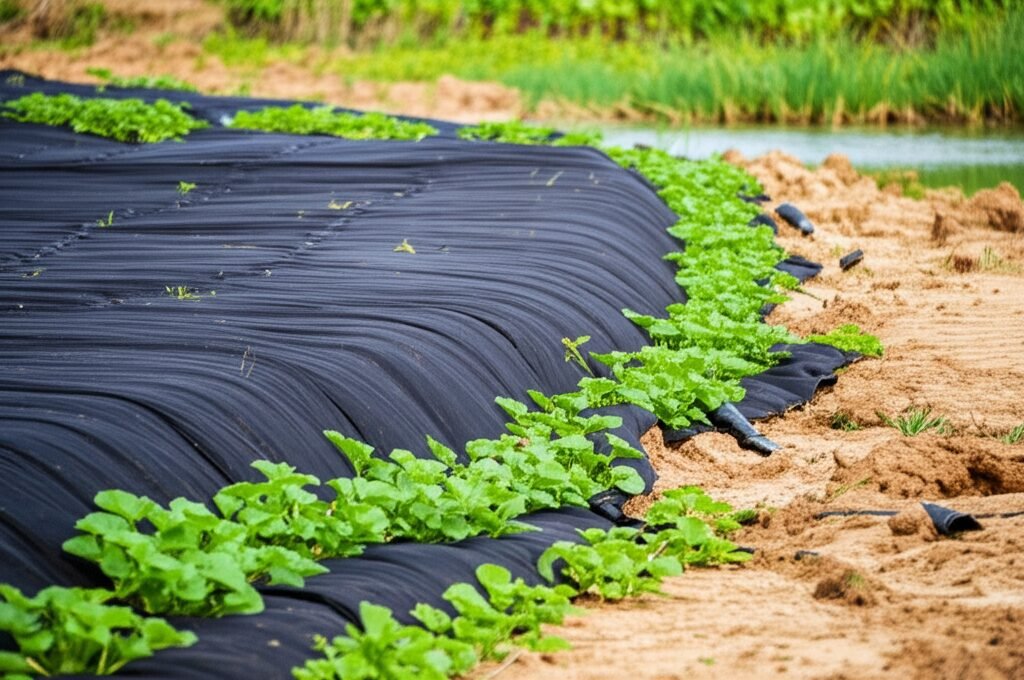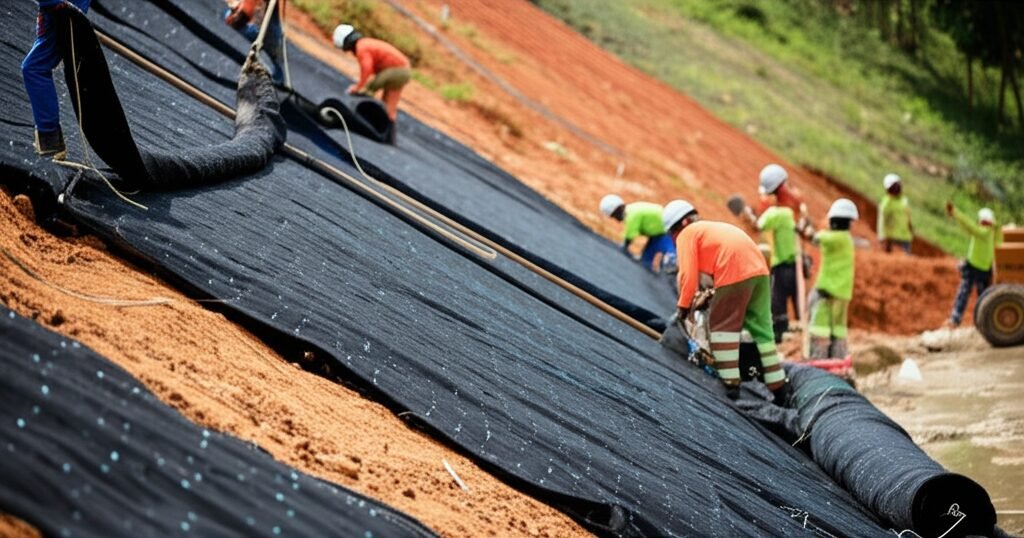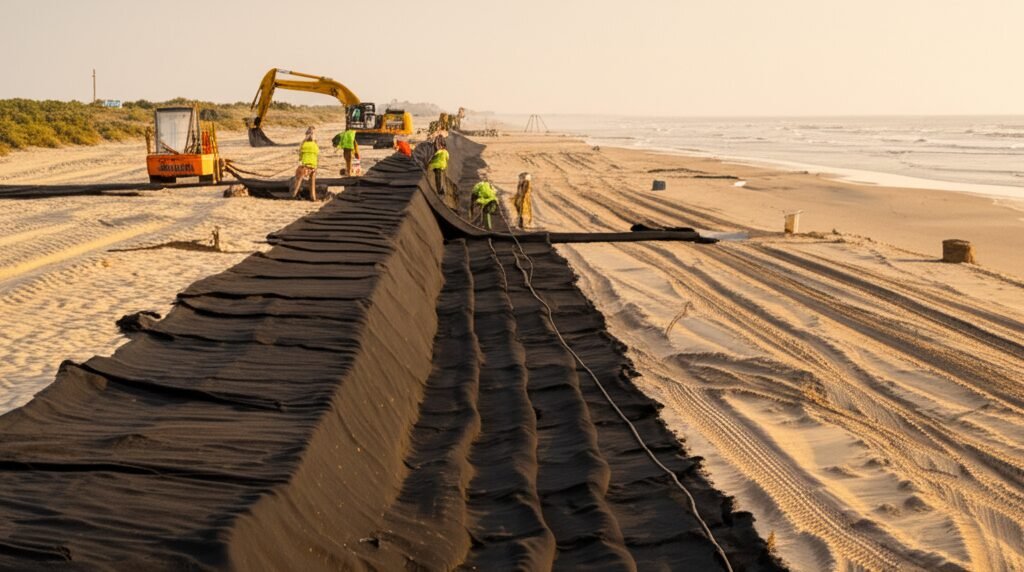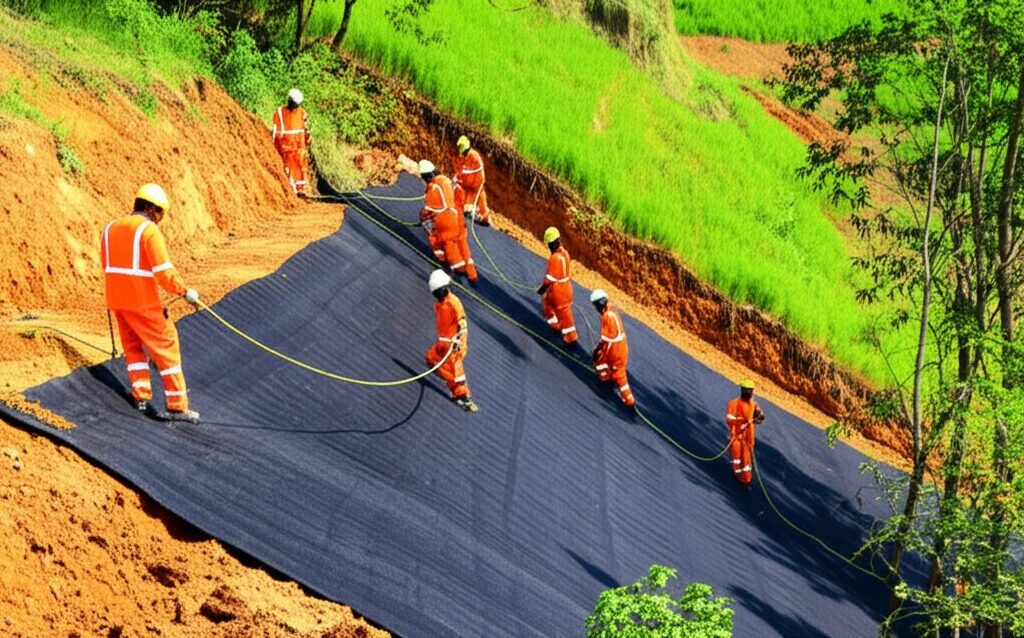Best Practices and Benefits of Geotextile Fabric Installation
Right then, let’s get into it. If you’re wonderin’ when to use geotextile fabric for keepin’ your ground where it oughta be, you’re in the right spot. It ain’t just some fancy cloth; this stuff’s proper useful.
Key Takeaways: When Geotextile Fabric is Your Best Bet
- Stopping Erosion: If you got slopes, riverbanks, or bits of shoreline where soil is always tryna wash away, geotextile fabric is what you need. It helps hold it all together.
- Making Ground Stronger (Stabilization): Think roads, driveways, retaining walls, or even just a new path. If the soil underneath is a bit weak or mushy, this fabric helps make it solid.
- Drains That Actually Drain (Filtration): Ever had a French drain get all clogged up with mud? Geotextile fabric stops the fine bits of soil gettin’ into your drainage pipes or gravel, so water flows free.
- Keeping Layers Separate: When you’re puttin’ down different types of stuff, like gravel on top of soil for a driveway, geotextile keeps ’em from mixin’ up over time. Each layer does its job better that way.
- Giving Soil Some Muscle (Reinforcement): Sometimes, soil just ain’t strong enough to hold up what you want to build. Geotextile can be used to add strength, kinda like rebar in concrete.
- Helping Plants Grow on Slopes: For them tricky steep spots where seeds just wash away, geotextile can give ’em a place to take root and hold on.
What’s the Deal with Geotextile Fabric and Why’s Ground Control So Darn Important?
So, geotextile fabric, eh? Sounds a bit technical, don’t it? But really, it’s just a special kinda material, a fabric, that we use in contact with soil and rock. Its job is to make the ground behave itself. You got different types, like woven ones that are strong and don’t stretch much, and non-woven ones that are more like a felt, good for letting water through but keepin’ soil back. Sometimes they make composites, mixin’ ’em up. The main idea behind most of these, specially when you look at things like Transform Terrains with Durable Geotextile Mattresses, is to solve ground problems that can cause a whole lotta headaches and cost a fortune if you don’t sort ’em out. Think about it, ground control, it’s fundamental. If your soil’s movin’, washin’ away, or sinkin’, nothin’ you build on it or near it is gonna be safe for long. It’s all about stability, mate.
Now, why does soil misbehave? Well, water’s a big culprit. Rain, rivers, waves – they all wanna pick up soil particles and carry ’em off. That’s erosion. Then you got gravity, always pullin’ stuff downhill, specially on slopes. And sometimes, the soil itself just ain’t got much strength; it’s too soft, too loose, and can’t support weight. This is where geotextiles really shine. They’re not just a barrier, they can separate different materials, filter water while holding back soil, reinforce weak ground, or help with drainage. It’s kinda like giving the earth a bit of an engineered helping hand. The Geosynthetics Industry Report 2025-2030 shows just how much this stuff is gettin’ used, ’cause more folks are realizing how good it is. Urbanization means more buildin’, and that means more need for reliable ground. It’s a smart move, using these fabrics, saves a lot of trouble down the line. I’ve seen projects where skippin’ on proper ground prep ended up costin’ double to fix later. A bit of fabric at the start coulda saved all that. It’s not just about big construction either; even for smaller landscaping jobs, gettin’ the ground right from the get-go is key.
Stopping Soil Washouts: Prime Times for Geotextile in Erosion Control
Erosion, that’s a big one where geotextile fabric really earns its keep. You got a hillside that’s slowly slippin’ away after every heavy rain? Or maybe a stream bank that’s gettin’ undercut and collapsin’? Construction sites are another classic – all that disturbed earth is just beggin’ to be washed into the nearest drain or river. This is precisely when you should be thinkin’ about geotextiles. The fabric, see, it does a couple of important things. First, it can act as a cover, directly protectin’ the soil from rain splash and the force of flowing water. This slows the water down, reduces its power to pick up soil particles. Second, for certain types, water can pass through it, but the soil particles get held back. This is super important for maintainin’ the structure of the slope or bank.
You can learn a lot about the Advantages and Applications of Geotextile Mattresses in Erosion Control, as these systems are specifically designed for these tough situations. They’re not just layin’ a sheet down; they often involve a structure that provides more robust protection. For really tricky spots, or if you’re not sure what’s best, you might need Expert Geotextile Mattress Solutions for Erosion Control to make sure the job’s done right. I recall a project near a river, the bank was eroding at an alarming rate, threat’ning a nearby road. We used a geotextile mattress system, anchored it proper, and within a season, you could see the difference. The bank stabilized, vegetation started comin’ back on its own in some parts, and the road was safe. Without that intervention, a big chunk of infrastructure woulda been at risk.
Think about these scenarios for deployment:
- Steep Slopes: Whether natural or man-made, like road embankments, slopes are prone to surface runoff carrying soil away.
- Riverbanks and Channel Linings: Constant water flow can erode banks. Geotextiles can protect them directly or act as an underlayment for rock armor (riprap).
- Shorelines: Wave action is a powerful erosive force. Geotextiles help protect coastal areas.
- Construction Site Perimeters: To prevent sediment runoff into waterways or onto neighboring properties.
- Around Culvert Outlets/Inlets: To prevent scouring where water flow is concentrated.
The key is early intervention. Don’t wait ’til half your garden’s slid down the hill. A well-chosen and properly installed geotextile can save a lotsa soil, money, and heartache. And it’s often a more environmentally friendly solution than just pouring concrete everywhere, ’cause it can allow for vegetation growth, which helps to bind the soil naturally too.
Greening Up Tricky Slopes: Geotextiles Giving Plants a Helping Hand
Got a steep bank or a newly graded slope that you want to see green and lush, but every time it rains, your soil and seeds just wash away? It’s a common problem, that. Plants need a stable place to get their roots down, and on a bare, angled surface, mother nature can be a bit harsh. This is another brilliant time to use geotextile fabric, especially some of the Advanced Vegetation Geotextile Mattress Systems for Slope Stability. These aren’t just any old sheets; they’re designed to hold soil in place, retain a bit of moisture, and give those tender young plants a fightin’ chance.
How it works is pretty clever. The fabric, often a non-woven type or a special mat, creates a kind of micro-environment. It protects the soil surface from the direct impact of raindrops, which can dislodge seeds and fine soil particles. It also helps to slow down water runoff, giving it more time to soak in, which is great for thirsty plants. Some geotextiles used for vegetation even have a bit of texture or pockets that physically trap seeds and soil. Once the plants start to grow, their roots weave through the fabric and into the soil beneath, creating a naturally strong and stable surface. The geotextile gives ’em that initial leg-up, and then the plants take over the long-term job of holding everything together. I worked on a reclamation project once, an old quarry site with some real nasty slopes. We laid down a vegetation-friendly geotextile, seeded it with native grasses and wildflowers. Took a bit of time, patience too, but after a couple of seasons, you’d hardly recognize the place. Went from a barren eyesore to a proper green habitat, all thanks to giving those plants a bit of engineered support to get started. It’s a lot better than looking at bare rock or eroding dirt, innit? Plus, more plants mean better local ecology.
Consider using geotextiles for vegetation when:
- You’re dealing with slopes steeper than, say, 3:1 (3 units horizontal to 1 unit vertical), where establishing plants is tough.
- The soil is poor or very easily eroded.
- You need quick green cover for aesthetic reasons or to meet environmental regulations.
- You want a long-term, self-sustaining solution for slope stability. Many geotextiles used for this are biodegradable, so once the plants are established, the fabric just naturally breaks down and becomes part of the soil. Others are made from durable polymers that continue to provide reinforcement. It just depends on what the specific site needs are.
Let it Flow, But Keep it Clean: Geotextiles in Drainage & Filtration
Water, it’s gotta go somewhere, right? But when it’s movin’ through soil, it likes to pick up little bits of dirt and carry ’em along. This is where you get problems with drainage systems. Think of a French drain – a trench filled with gravel around a perforated pipe. It’s meant to collect excess groundwater and carry it away. But if fine soil particles from the surrounding earth wash into the gravel and then into the pipe, pretty soon the whole thing clogs up and stops workin’. That soggy patch in your garden you thought you’d fixed? It’s back. This is a classic scenario where geotextile fabric is an absolute lifesaver. Specifically, systems like Advanced Filtration Geotextile Mattress Systems are designed for these exact situations.
The fabric acts as a filter. It’s clever stuff; it’s gotta have pores big enough to let water pass through easily, but small enough to hold back most of the soil particles. So, you’d typically line the trench with the geotextile before you put the gravel and pipe in, then wrap the fabric over the top of the gravel before backfilling with soil. This creates a protective barrier all around your drainage medium. Water seeps in, dirt stays out. Simple, but so effective. It’s not just for French drains either. You use ’em behind retaining walls to stop the backfill soil from washing through weep holes and causing pressure build-up or blockages. They’re used under permeable paving systems – them fancy driveways or patios that let rainwater soak through – to prevent the sub-base from getting contaminated with fines from the soil below.
One thing you gotta be careful with, as an expert I can tell ya, is pickin’ the right fabric for the soil type. If your soil has really fine particles, like clay, you need a geotextile with a smaller opening size (they call it Apparent Opening Size, or AOS). If you use one with openings that are too big, them fine particles will still get through. If the openings are too small for the amount of water, it can clog the fabric itself over time, which is called blinding. So, there’s a bit of a science to it, matching the fabric to the job. But get it right, and your drains will keep flowin’ clean for years. I’ve seen so many drainage systems fail prematurely ’cause they skipped the geotextile step to save a few quid. False economy, that is. It ends up costin’ way more to dig it all up and do it again properly.
Strong Foundations, Lighter Bills: Soil Stabilization and Separation with Geotextiles
Sometimes the ground you’re workin’ with just ain’t up to snuff. It’s soft, it’s squishy, maybe it’s a mix of good stuff and rubbish. If you try to build a road, a path, or even put down a shed on ground like that without doin’ somethin’, you’re askin’ for trouble. Things will sink, get ruts, and generally fall apart. This is where geotextile fabric steps in for soil stabilization and separation. It’s a game changer, especially when you consider options like Raised-Pattern Geotextile Mattress Systems Cut Costs 40%, which shows how smart engineering can save you dosh. And to really get a grip on how these systems work, checkin out a Geotextile Mattress Uses, Construction, Benefits & Installation Guide is a smart move.
So, how’s it work? Two main ways here:
- Separation: Imagine you’re building a driveway. You dig out the soft topsoil and you’re gonna put down a layer of good, strong aggregate (like crushed stone) for your base. If you just dump that stone onto the soft subgrade soil, over time, especially with traffic pushing down, the stone will get pushed into the soft soil, and the soft soil will ooze up into the stone. They mix. Your nice strong base layer gets contaminated and weaker, and you need more stone to start with to compensate. Put a layer of geotextile fabric between the soft subgrade and your aggregate layer, and it keeps ’em separate. The aggregate stays clean and strong, and you often need less of it, which saves money on materials and hauling.
- Stabilization/Reinforcement: Some geotextiles, especially the woven ones or geogrids (which are related), can actually add strength to the soil. When you lay ’em down and put fill on top, they help to distribute the load over a wider area. This reduces the pressure on the weak subgrade and prevents it from deforming or failing. It’s kinda like how snowshoes stop you sinking into deep snow. For soft soils, this can mean the difference between a project being feasible or not, or it can significantly reduce the amount of excavation and replacement of poor soil you need to do.
I remember a job years back, a temporary access road for heavy trucks on a really boggy site. Without geotextile, we’d have had to dig out feet of muck and bring in tons of stone. Instead, we laid down a tough woven geotextile, put a thinner layer of aggregate on top, and it worked a treat. Saved the client a bundle, and the road held up for the whole project. It’s not just for big roads; even for a garden path or a base for a patio on iffy ground, a bit of fabric can make a huge difference to how long it lasts and how good it looks. The emphasis on sustainable construction you read about in reports like the United States Geotextile Industry Research 2024-2029 is partly because these materials can reduce the need for quarried aggregates and minimize site disturbance. Smart stuff.
Holding the Line: Geotextiles Protecting Our Shores and Waterways
Coastlines and riverbanks, they’re dynamic places, always changin’. But when that change means losin’ valuable land, or threat’ning homes and infrastructure, then we got a problem. Water, whether it’s waves crashin’ on the beach or a river in full flow, has a tremendous power to erode. This is another key area where geotextile fabrics, often as part of engineered systems, are absolutely vital for holdin’ the line. You’ll see them used in all sorts of coastal and river defence works, from small local projects to massive civil engineering schemes. The Proven Geotextile Mattress Projects for Water Infrastructure page shows some real-world examples of how effective these can be.
So, when are they used? Well, pretty much any time you’re tryin’ to stop soil being washed away by water in these environments. For instance:
- Under Riprap or Rock Armour: Large rocks (riprap) are often placed along shorelines or riverbanks to break the force of waves or currents. If you just dump these rocks on bare soil, the water action can wash out the soil from underneath and between the rocks, causing them to settle and become less effective. A layer of robust geotextile fabric placed underneath the rocks acts as a separator and filter. It prevents the soil from washing out but still allows water pressure to release, makin’ the whole structure much more stable and long-lasting.
- Scour Protection: Around bridge piers, culvert outlets, or the toes of revetments, fast-flowing water can dig out “scour holes,” underminin’ the structure. Geotextile mats or mattresses can be laid down to protect the bed of the river or seabed from this scouring action.
- Revetments and Seawalls: Geotextiles are often incorporated into the design of these structures, either as a filter layer behind them to prevent loss of backfill material, or as part of a softer, more flexible revetment system using geotextile containers filled with sand or grout.
- Artificial Reefs and Breakwaters: In some cases, large geotextile tubes or bags filled with sand are used to create submerged breakwaters or artificial reefs, which help to reduce wave energy before it reaches the shore.
One specific application you might see is the Geotextile Mattress for Coastal Erosion Control. These are engineered systems that can be filled with concrete grout or sand, conforming to the shape of the shoreline or bank to provide a durable, protective layer. They’re pretty versatile. As an expert, I’ve seen these mattress systems work wonders where traditional hard defenses might be too expensive or visually intrusive. They can often be designed to encourage marine life or allow for some vegetation to establish, which is a bonus. The key is that they stop the fine material from being washed out, which is the start of most erosion problems in these settings.
Big Jobs, Big Solutions: Geotextiles in Critical Infrastructure Projects
When we talk about critical infrastructure – things like landfills, reservoirs, canals, big dams, and major transportation corridors – the stakes are incredibly high. Failures in these systems can have catastrophic environmental, economic, and even human consequences. So, the ground engineering has to be absolutely spot on. And yep, you guessed it, geotextile fabrics play a massive, often unseen, role in ensuring the safety and longevity of these big jobs. You’re lookin’ at applications where you need Specialized Geotextile Protection for Critical Infrastructure because the demands are just that much greater.
Here’s a few examples of where these wonder fabrics are put to work on a grand scale:
- Landfill Engineering: Modern landfills are complex engineered systems designed to contain waste and protect the environment. Geotextiles are used in multiple layers. They act as a protective cushion for geomembrane liners (the plastic sheets that stop leachate leaking out), preventing punctures during construction and from the waste itself. They’re used as filter layers in leachate collection systems, allowing the contaminated liquid to drain away for treatment without clogging the pipes. And they’re used in capping systems when the landfill is full, again for protection, filtration, and drainage.
- Reservoirs and Canals: To prevent water loss through seepage, reservoirs and canals are often lined with geomembranes. Just like in landfills, geotextiles are used to protect these liners from damage. They can also be used for bank stabilization within canals to prevent erosion from water flow or boat wash. The work being done on Proven Geotextile Mattress Projects for Water Infrastructure often touches on these types of large-scale water management solutions.
- Dams: In earth dams, geotextiles can be used as filters in internal drainage systems to control seepage safely, preventing internal erosion that could lead to dam failure. They can also be used for erosion protection on the upstream or downstream faces.
- Roads and Railways over Soft Ground: We touched on stabilization before, but for major highways or railway lines built over very poor soils (like peat bogs or soft clays), high-strength geotextiles or geogrids are essential. They provide reinforcement, reduce differential settlement, and can significantly cut down on the amount of imported fill material needed, making the project economically viable and more sustainable.
For these kinds of projects, you’re not just pickin’ any old fabric off the shelf. The specifications are incredibly strict. The geotextile has to be proven to last for decades, sometimes even a hundred years or more, often in harsh chemical environments or under significant stress. Manufacturers like the ones associated with experts like Li Gang: Expert Geotextile Mattress Manufacturing Leader are at the forefront of developing and producing these high-performance materials. It’s serious engineering, and the reliability of these geotextiles underpins the safety of a lot of the infrastructure we depend on every day, even if we don’t see ’em.
Getting it Right: Geotextile Installation and What Makes a Good ‘Un
So you’ve decided geotextile fabric is the way to go for your project. Brilliant! But hold your horses a sec. Just havin’ the right material ain’t quite enough; you gotta install it proper, otherwise it might not do the job you want it to, or it might not last as long as it should. And you also need to know you’re gettin’ a decent quality fabric in the first place. When it comes to systems like geotextile mattresses, understanding The Function and Benefits of Grout in Geotextile Mattress Construction is key, as this is often an integral part of the system’s strength and function.
Let’s talk installation basics first, though it’ll vary a bit dependin’ on the specific application and type of fabric:
- Prepare the Ground: This is crucial. The surface where the geotextile is going needs to be reasonably smooth. Get rid of any sharp rocks, roots, or bits of debris that could puncture or damage the fabric. For some jobs, like under a road, you might need to grade it to the right level and compaction.
- Unroll and Position: Lay out the fabric carefully. Try to avoid draggin’ it too much over rough ground. For slopes, you usually start at the top and roll it downwards. For wider areas, you’ll have multiple strips.
- Overlap Properly: This is a biggie. Where two pieces of fabric meet, they need to be overlapped. The amount of overlap depends on the application and the soil conditions, but it could be anything from 12 inches to 3 feet or more. If water’s gonna flow over it, you want the upstream fabric overlapping the downstream one, like tiles on a roof, so water doesn’t get underneath.
- Secure it: Geotextile can be light, so wind can be a pain. You’ll need to secure it, especially at the edges and overlaps. This can be done with special ground staples (look like giant hairpins), pins and washers, or by trenching the edges in and burying them. Sometimes just the weight of the material you put on top (like gravel or soil) is enough, but get it secured initially.
- Avoid Damage: Once it’s down, try not to drive heavy machinery directly on the exposed fabric unless it’s designed for that. When you’re placing material on top, do it carefully to avoid shifting or tearing the fabric.
Now, what makes a “good ‘un” when it comes to the fabric itself? Well, it needs to have the right properties for your specific job. Things like tensile strength (how hard you can pull it before it breaks), puncture resistance, permittivity (how easily water flows through it), and apparent opening size (AOS, which relates to the size of soil particles it can retain) are all important. A reputable supplier will provide a data sheet listing all these properties. For something like a Flexible Installation: Quick, Simple Setup & Adaptability Guide, the material itself has to be up to the task of being manhandled and conformed to different shapes. Look for materials that are UV stabilized if they’re going to be exposed to sunlight for any length of time, though most are buried pretty quick. Durability is key – you want something that’s gonna last. It ain’t worth savin’ a few pennies on cheap, flimsy stuff that’ll fall apart in a year or two. A good geotextile, installed right, is an investment that pays off. For complex jobs, especially those involving engineered mattress systems or critical infrastructure, it’s always best to follow the manufacturer’s specific guidelines or get an expert involved.
Frequently Asked Questions (FAQs)
- What is geotextile fabric mainly used for?
Its main jobs are erosion control (stopping soil washing away), soil stabilization (making ground stronger for roads or paths), drainage (helping water flow cleanly), and separation (keeping different soil or aggregate layers apart). - Can I use geotextile fabric in my garden?
Yes, definitely! It’s great for things like lining French drains, putting under gravel paths to stop weeds and keep the gravel clean, or even at the bottom of planters to help with drainage and stop soil washing out. - How long does geotextile fabric last?
It depends on the type of fabric and where it’s used. If it’s buried and protected from sunlight, good quality geotextiles can last for many, many years – decades even. Some are designed to be very long-lasting for critical projects. - Is geotextile fabric expensive?
The cost varies a lot based on the type and quality. Basic landscape fabric for weed control is pretty cheap. Heavy-duty stuff for civil engineering projects will cost more. But often, using it saves money in the long run by reducing the need for other materials or preventing costly repairs later. - Do I need a professional to install geotextile fabric?
For simple jobs like a garden path or a small drain, a keen DIYer can usually manage it by following instructions. For bigger or more critical projects, like a large retaining wall, significant erosion control, or road sub-bases, it’s often best to get a professional involved to make sure it’s done right. - What’s the difference between woven and non-woven geotextile?
Woven geotextiles are made by weaving strands together, kinda like a sack. They are usually very strong and don’t stretch much, good for stabilization and reinforcement. Non-woven geotextiles are more like a felt, made by bonding fibres together. They are generally better for filtration and drainage because water can pass through them more easily in all directions, and they have smaller, more random pore openings.


